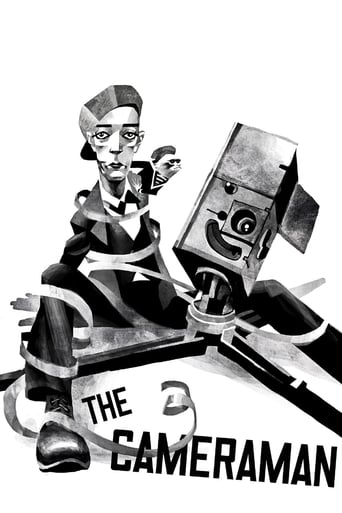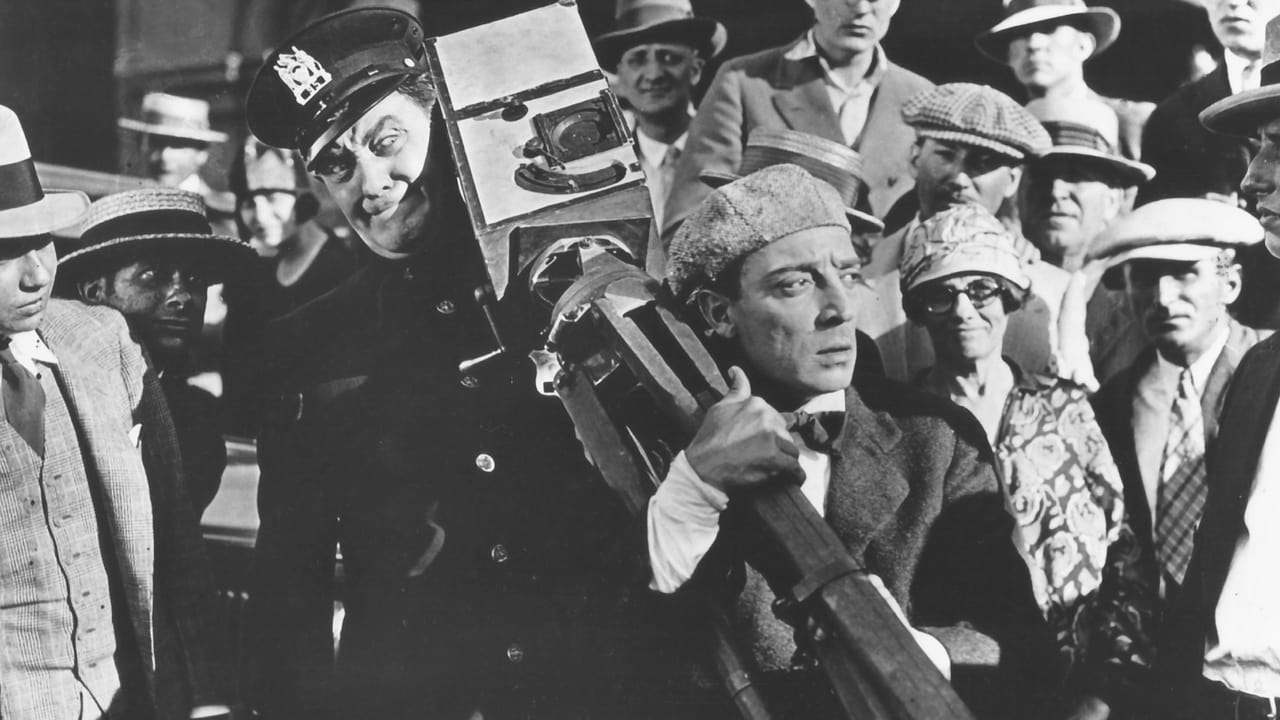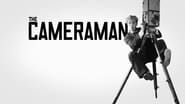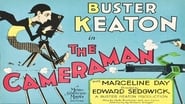LenaAndBarry
The films kickoff — the first 15 minutes or so — had me exceedingly apprehensive. The slapstick was easy and uninspired, and to top that off, was shot and edited awkwardly; the Keaton that I knew was unrecognizable. Very worried was I at the thought of the first feature film of Buster's that I'd see, going on to be the first bad one as well. Perhaps that level of anxiety is what caused the eventual, stretched sigh-of-relief, I let go of, to be *so* heavy.The exact point where the dispassionate- faced, insecure, and unwittingly suave Buster that I've quickly grown to love, done with his stretching, came to play, was at the scheduling of the walk. That second onwards: smooth sailing! Whatever the task was — slips, slides, and falls, to something as elementary as running — Keaton performed it to perfection, and all, *impressively*, topped, and perhaps made, with his facial expressions (or lack thereof). *This*, and his creative touch are what were missing in those drab 15 minutes.The, as always, inventive gags, while each being funny, steadily improved. Beginning at the simple and grin-inducing stairs sequence, and ending at the invigorating spectacle that was the Tong War — where, unlike the muddled parade scene at the start, it was able to be chaotic/hectic while simultaneously being comprehensible.If you've seen the picture, you've probably realized I've gone without speaking of the final 10 minutes. I wish I could say that because its predecessor (Tong) was such an exhilarating experience, the ending just couldn't follow and ultimately underwhelmed me. But the sad truth is that it simply felt tacked on. I'd like to think that there wasn't enough room in the budget, rather than them just not knowing how to end it. But whatever the reason, it's a bummer. That the film's edges were both disappointing is, well...disappointing; the scenes linking the two were such a delight however, that in the end, the film won me over.
Edgar Allan Pooh
. . . a decade before MGM got all uppity from GONE WITH THE WIND (which I always suspected was mostly filmed by junior members of the primate family, who probably also wrote the script for GWTW's mendacious opening scroll). As the title character of THE CAMERAMAN, Buster Keaton was hired to represent the average Tinsel Town filmmaker. He's a constant bumbler in this role, breaking MGM's stenciled glass door panel six times with his camera tripod. On one of his rare excursions outside, Keaton blindsides and knocks unconscious an organ grinder's Capuchin monkey. As soon as the abandoned midget primate regains consciousness, he commandeers Keaton's camera and shoots the "best footage" MGM's boss has "seen in years," despite being woozy and saddled with the most antique camera the city has to offer. Naturally, Specism prompts the MGM mogul to assume Keaton deserves all the credit, and the REAL cameraman finishes his big day out as an unsung (and unemployed) hero. Obviously, it turns out that THE COVE and BLACKFISH were not the first flicks to document mammal abuse!
romanorum1
Film historians know that Buster Keaton signed on as a contract player with MGM Studios after his contract with independent producer Joseph M. Schenck expired in 1928. His signing was done at the urging of his relatives but against the advice of mega-star comedians Charlie Chaplain and Harold Lloyd. An advantage of the new arrangement was that there would no longer be problems of raising cash since MGM was large and rich. A disadvantage is that Keaton gradually gave up his filmmaking independence, like directing and improvising, to a studio that insisted upon strict control. Even though the box office tabulation would undeniably improve – MGM moguls could claim that they were right after all – the payoff over time would be disastrous for one who was a silent film giant. But the day seemed to be ending for 1920s slapstick silent stars. New comedians were on the rise, like the Marx Brothers (whom Keaton loathed). Whatever Keaton's future problems, the new agreement certainly began well, as his first MGM effort, The Cameraman, shows little, if any, waning from some of his great movies. There are gags galore, and pathos, and on-location shooting, and more. Keaton is a clumsy tintype photographer (appropriately named Buster) who desires to become a great studio newsreel cameraman at MGM Offices in order to impress Sally, a lovely lass. He had met her at a ticker-tape parade (which looks very much like a World War I coming-home gala, 1919). But Buster's first efforts are hopeless, as his double-exposures leave the studio chiefs laughing in stitches. Meanwhile he has inadvertently broken the door glass at MGM several times. So it is that Buster embarks upon New York City to find stories to film while wielding a lumbering movie camera. The upshot is that there are many funny vignettes. Here are a few: (1) The one-man baseball-pantomime at Yankee Stadium with a Ruthian figure in civilian clothes – with hands on hips – observing the action. Actually Buster, looking for action, did not realize that the Yankees were playing the St. Louis Browns on the road that day. (2) Buster running non-stop from his Manhattan place to Sally's before she has hung up the telephone. (3) Buster's attempts to break into his piggy-bank to gather his precious dimes; he damages his apartment. (4) The separation of Buster and Sally on two different levels of the over-crowded Manhattan bus. (5) The clothing change in a locker room. By the way, Sally (Marceline Day) looks fabulous in her 1920s bathing gear. (6) Buster losing his over-sized bathing outfit while in the pool. (7) The hilarious Tong War in Chinatown, with a monkey in a sailor-suit using a machine gun. This scene reminds one of Cheetah machine-gunning Nazis who had invaded Tarzan's African domain years later (1943). (8) The boating scene whereby Buster saves Sally from an unmanned motorboat. His rival, though, initially received the credit and left the romantic Buster heartbroken. It's serendipity that the monkey knew how to operate the movie camera! Look fast for Charles Lindbergh in the parade at movie's end (newsreel footage). This film was followed by Keaton's last silent (with sound effects but without dialog) – the humorous but underrated Spite Marriage (1929). Soon after conditions deteriorated, as 1930 was just around the corner, and the decade of the 1930s was Keaton's worst decade in more ways than one. The star's later state of affairs was not helped along by his extramarital affairs and his drinking. But, for now, the situation looked fine for one whom Roger Ebert ultimately considers the most courageous silent movie comedian of all time. Indeed, Buster Keaton was a unique comedy talent, maybe the greatest one in world cinema history.
kidboots
"The Cameraman" (Buster's first film with MGM) was extremely popular and it was more like the films Buster made when he was his own boss. Although there were rumblings behind the scenes. Harold Goodwin (Stagg) said that while the director Edward Sedgewick tended to let Buster develop gags at his own pace - the front office was aghast because the script wasn't being followed - and started to reign him in. I think this is one of Buster's funniest movies and for the first time he finds a heroine who is not dumb, holds down a responsible job and treats Buster with the respect he deserves.Beautiful Marceline Day (Sally) was the perfect decorative co-star for big stars like John Barrymore ("The Beloved Vagabond") and Lon Chaney ("The Big City" and "London After Midnight"). She was also right for "jazz age" movies ("Restless Youth", "The Jazz Age" and "The Wild Party") and as well, appeared as a bathing beauty in Harry Langdon's first film "Picking Peaches". Apparently when she retired she didn't want to talk about her career and didn't grant interviews but I think out of all the "lovely young things" she had a career to be most proud of. In "The Cameraman" she plays Sally the girl of Buster's dreams.Buster is a tintype photographer who meets Sally during a ticket tape parade. He takes her picture but before he can give it to her - she is whisked off to her job as a receptionist at the MGM Newsreel Department. He trades in his tintype so he can be a newsreel man. After being sent to cover a fire (which he can't locate), then finding the Yankees are playing .... in St. Louis!!! he covers a one man baseball game starring Buster!!! When he puts his film reel in, the double exposure found battleships, baseball games and busy traffic scenes all in the same frame!!! I found that an amazing piece of photography. After some encouraging words from Sally he waits for her to call the next day. in the meanwhile destroying his room in an effort to break into his piggy bank. Then follows just the funniest scene, in which Sally is talking to Buster over the phone - Buster in his excitement runs the several blocks to her house, to get there just as she puts down the phone, thinking he has hung up!!! There is a very funny sequence at the baths where Buster gets the wrong costume, then loses it altogether - Sally proves a hit at the baths, where men cluster around her like bees around a honeypot - they find it hilarious that she could prefer Buster. The day ends for him with a run-in with the local policeman, as wet and forlorn the cop takes him for a homeless person.Sally gets news of some doin's in Chinatown - wanting to see Buster make good she gives him the scoop. So Buster and "de monk" - cover a Tong War. Buster is again in disgrace when he can't find the film he has shot. Stagg (Harold Goodwin), who is the "bad guy" of the film, takes Sally boating but when they both fall out, swims off in fright, leaving Sally in the water at the mercy of an out of control motor boat. Buster to the rescue - but when he goes to the drug store Stagg comes by and Sally thinks he has saved her. All is not lost as "de monk" has been doing some camera-work on his own and has filmed Busters' rescue of Sally on the end of the missing Tong War reel.I would highly recommend this film as I found it a lot more enjoyable than "The General". The expression conveyed in Buster's eyes is just so soulful.



 AD
AD






